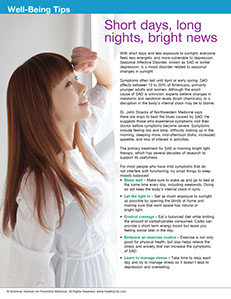SYMPTOM CHECKER
CONDITIONS
Male
Female
Child
Arm, Hand & Shoulder Concerns
Legs & Feet Concerns
Dental & Mouth Concerns
Ear & Nose
Eye Conditions
Head Conditions
Arm, Hand & Shoulder Concerns
Legs & Feet Concerns
Front
Back
Arm, Hand & Shoulder Concerns
Dental & Mouth Concerns
Ear & Nose
Eye Conditions
Head Conditions
Arm, Hand & Shoulder Concerns
Dental & Mouth Concerns
Ear & Nose
Eye Conditions
Head Conditions
Front
Back
Arm, Hand & Shoulder Concerns
Neck Links
Head & Neck Concerns
Arm, Hand & Shoulder Concerns
Neck Links
Head & Neck Concerns
Front
Back
Online Clinic
Wise Healthcare
Short days, long nights, bright news
Print on Demand
With short days and less exposure to sunlight, everyone feels less energetic and more vulnerable to depression. Seasonal Affective Disorder, known as SAD or winter depression, is a mood disorder related to seasonal changes in sunlight.
Symptoms often last until April or early spring. SAD affects between 10 to 20% of Americans, primarily younger adults and women. Although the exact cause of SAD is unknown, experts believe changes in melatonin and serotonin levels (brain chemicals), or a disruption in the body’s internal clock may be to blame.
Dr. John Stracks of Northwestern Medicine says there are ways to beat the blues caused by SAD. He suggests those who experience symptoms visit their doctor before symptoms become severe. Symptoms include feeling low and slow, difficulty waking up in the morning, sleeping more, mid-afternoon blahs, increased appetite, and loss of interest in activities.
The primary treatment for SAD is morning bright light therapy, which has several decades of research to support its usefulness.
For most people who have mild symptoms that do not interfere with functioning, try small things to keep moods balanced:
• Sleep well – Make sure to wake up and go to bed at the same time every day, including weekends. Doing so will keep the body’s internal clock in sync.
• Let the light in – Get as much exposure to sunlight as possible by opening the blinds at home and making sure that work space has natural or bright light.
• Control cravings – Eat a balanced diet while limiting the amount of carbohydrates consumed. Carbs can provide a short-term energy boost but leave you feeling worse later in the day.
• Embrace an exercise routine – Exercise is not only good for physical health, but also helps relieve the stress and anxiety that can increase the symptoms of SAD.
• Learn to manage stress – Take time to relax each day and try to manage stress so it doesn’t lead to depression and overeating.
This website is not meant to substitute for expert medical advice or treatment. Follow your doctor’s or health care provider’s advice if it differs from what is given in this guide.
The American Institute for Preventive Medicine (AIPM) is not responsible for the availability or content of external sites, nor does AIPM endorse them. Also, it is the responsibility of the user to examine the copyright and licensing restrictions of external pages and to secure all necessary permission.
The content on this website is proprietary. You may not modify, copy, reproduce, republish, upload, post, transmit, or distribute, in any manner, the material on the website without the written permission of AIPM.
2021 © American Institute for Preventive Medicine - All Rights Reserved. Disclaimer | www.HealthyLife.com
















































